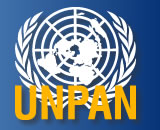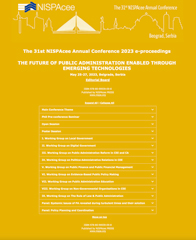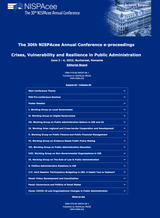CONCLUSION:
TOWARDS THE NEO-WEBERIAN STATE?
PERHAPS, BUT CERTAINLY ADIEU, NPM!
Wolfgang Drechsler and Rainer Kattel [1]
Are we, or so the question had been at the outset of the first Trans-European Dialogue, on the way towards the Neo-Weberian State (NWS)? The answer, not exactly surprising for a high-level conference of scholars, experts and professionals, was: It depends. It depends on the definition of the NWS, on the nature – is it a model, a matrix, a research agenda? –, on the countries or regions in question, on the normative vs. empirical aspects, and of course on the individual conception and the extent to which New Public Management (NPM) fits into one’s own research agenda.
The idea of TED was, as the name says, to bring together people from ‘East’ and ‘West’ and indeed, perhaps somewhat surprisingly, it was clear that a larger majority of participants from Central and Eastern Europe (CEE) were in favour of the NWS than of those coming from the ‘Old West’. However, this difference seems to be founded in the very concept of the NWS and its genesis. In order to sum up the discussions at TED, we can draw three key conclusions:
First, the NWS as an empirical concept has a distinctive background in Continental European developments and incorporates in many ways the European answer to economic globalization. Indeed, as Pollitt described the process how the concept of NSW was born, when analyzing Continental reform efforts in the late 1990s and early 2000s, it become clear that these activities could not be placed on a simple more NPM – less NPM scale. Instead, the Continental reforms, while varying to a significant degree between countries, were based on three fundamental premises according to Bouckaert:
1) to keep the state as the primary framework;
2) to use the law as the steering instrument of the framework; and
3) to not experiment with state, administration and other such important issues.
The Continental states more or less accept a strong state and seek to modernize it, rather than to minimize it (in contrast to the Anglo-American countries). Thus, looking at the empirical aspects of the NWS concept, one can conclude with Pollitt that the NWS is a political response to some of the forces of globalization that attempts to preserve the European social model directly threatened by the processes of globalization. The "neo” elements preserve the main part of the traditional Weberian model and modernize it (which, again, can take various context- and country-specific forms). The NWS does not say whether it works but brings out the political mood and the incremental changes specific to the context of Continental Europe. Thus, it would not be correct to call the NWS a strategy (since the changes have been incremental) but a political orientation. Empirically, the basis of the NWS remains the Weberian structure to which some of the NPM elements have been added (rather than Weberian elements added to NPM).
Second, while the NWS has clear empirical origins, in recent years the concept has also obtained a strong normative meaning for middle-income and less-developed countries (e.g., CEE), where it serves as a critical reminder that before public administration (PA) modernization (such as NPM reforms), one needs Weberian PA that can be modernized, and that there is a clear linkage between sustained economic growth and Weberian PA. Indeed, as numerous participants argued during the discussions, there is a whole thread of recent publications that point out that if NPM reforms were to work well at all, they would only do so on a strong Weberian basis – an aspect that implies complementarities between Weberian PA and NPM. Ironically, it appears that NPM cannot be successful, if at all, without a traditional, solid, stable, neutral bureaucracy. This, however, has huge connotations for CEE and also for many Southern European countries where NPM-style reforms abound, yet solid Weberian structures are hardly in place. As Ongaro, Spanou and others stressed in the discussion, for such states, Weberian reforms are normatively desired, and this makes the NWS a very attractive explicit reform strategy for these countries. This is strongly corroborated by the empirical connection between Weberianism and sustained economic growth. (See Evans and Rauch 1999)
Indeed, the NWS seems to be the perfect match for an innovation-based society, contrary to NPM. Innovation in the general interest, rather than that of an individual entrepreneur, is a question of successful innovation policy, and who should implement that if not the administration? L’innovation, une affaire d’état, as Claude Rochet succinctly put it (2007). To put it simply, innovation-based economy asks for, draws upon, and requires a highly competent, long-term-oriented, dedicated and enabled civil service to implement it, not without the societal actors either, but certainly not without public administration. If we follow Carlota Perez’ great surges theory and her model of Techno-Economic Paradigm Shifts (2002), we can also observe that, as we are in the middle of the ICT paradigm and heading towards a new one in the distance, at this moment, after the collapse and before heading towards "synergy,” state and administration are expected to take up their great tasks again and the anti-state climate of the earlier installation period of ICT is, or should be, over. And whatever the new leading technology will be – nanotech, biotech, convergence or something completely different –, its setup will require a particularly capable state actor and a science and technology policy implemented by a civil service that is denoted by long-term thinking, high competence, and tolerance for mistakes – the opposite of NPM. (Drechsler 2008) In other words, the period in history we are now entering, and this goes for the next 20-30 years, is bound to be much more state-friendly than the 1990s, and the NWS seems to be one of the most interesting theoretical and normative answers to the question of how to govern or steer (as argued also by Peters in the discussion) a complex innovation-based society. However, as Pollitt posed the question, is it possible to establish Weberian PA after we have tried to create NPM in a place where Weberian PA was missing at first? In sum, while the NWS might be normatively desired in CEE countries and elsewhere, we have fairly little theoretical and empirical knowledge how to actually go about and "produce” it.
Third, as the NWS is a concept with both clear empirical and normative facets, it becomes evident that the very concept of modernization or change in PA (and the NWS is part of this process) needs serious theoretical development if we are to avoid change for the sake of change as seems to have been the case with so many NPM-inspired reforms. Indeed, the idea of modernization itself should be clarified, what does ‘modern’ really mean? More often than not, PA reform documents but also PA scholarship appear to rely on highly reductionist and completely vague idea of modernization (e.g. better service provision). In any meaningful sense in this context, ‘modern’ can not mean anything specific, but ‘in line with the times’, ‘in line with the current situation.’ ‘Modern’ in the sense of ‘new’ is surely not only an ambiguous, but also a highly ambivalent concept by now, after the experiences of the 20th century – would a totalitarian shift away from democracy be better simply because of being the new thing? What, if not ‘appropriate for the circumstances of the times’, could ‘modern’ mean except merely ‘fashionable’? What would be bad about an appropriate, well-working, traditional solution? What is appropriate, however, depends on the times and the situation, and the problem is that the vast majority of claims in documents surrounding public administration use ‘modern’ to denote a concept that is exactly not in line with times and situation at all. The most powerful element of NPM, perhaps, was that it was "new”. It sounded hip and cool and in administrative reforms, there is often an emphasis on fashion. However, today this may very well be said about the NWS as well. As Pushkarev argued in the debate, Russia and other countries where democracy has a difficult stance would also applaud the idea of a strong modernizing state or the NWS. That is, starting with the idea of a strong state may be too one-sided for such a context; it may send a wrong message about modernization, and this means that we need to include the aspects of civic society and participation in the discussion. In that sense, it could be argued that the NWS presupposes a viable democracy next to the Weberian bureaucracy.
In sum, NPM, it turned out, did not really have any defenders left in Tallinn. And even those participants usually grouped with NPM conceded that NPM is not based on current economics and business administration but rather on simplified or outdated versions. (Hence, a sizable criticism of NPM on the highest level comes precisely from those who would like PA to learn from economics.) This is why respective economic and especially management-theoretical insights could only establish themselves after the end of the dominance of NPM, which as a genuine ideology was not open even for arguments stemming from its own leading method. NPM reforms created, for instance, quasi-markets within administrative organizations in order to create market behaviour: yet, such behaviour can only develop in genuine and not in quasi- (i.e. pseudo-) markets. (See König 2001: 6–7) Another example is the problem of the concept of performance pay vis-à-vis the demands of multitasking and motivation through identification with the organization (Akerlof and Kranton 2003: esp. 9–11, 27–29). But as Lawrence Lynn, Jr., pointed out during the discussion, if any concept in the social sciences is disproved, it is that of performance pay – and yet, it is politically pushed and implemented.
So, the NWS might not be the way of the future, at least not everywhere, in every form, and in every respect, but NPM is certainly dead – not as dead as a door-nail, perhaps, but among scholars not a viable option anymore. And this was long before the events of the Fall of 2008 that really hit home to the public discourse of even the most die-hard neo-liberal that to give up on the state was premature, to say the least. Nothing has become clearer than the strong time dimension of NPM. In that sense, the criticism towards the NWS that it is too close to NPM (such as by Samier) is justified to the extent that it does co-opt positive elements of NPM, but on a Weberian foundation, i.e. that both are asymmetrically aufgehoben.
The NWS was intended as an empirical-analytical, not as a normative model, and one of its creators, Pollitt, is quite self-critical about several of its aspects, but it stands so far as one explanatory model of what is going on in Europe, and it does not throw good managerialist – and participatory – babies out with the NPM bathwater. It does still form a research agenda, but in lieu of anything better, it significantly helps our understanding of contemporary public administration. And as regards the needed additional research – let’s get to it!
References
Akerlof, George A., and Rachel E. Kranton. 2005. Identity and the Economics of Organizations. Journal of Economic Perspectives9 (1), 9–32.
Drechsler, Wolfgang. 2008. nanoGov – Nanotechnologie, Governance und Verwaltung. In Nanotechnologie – Grundlagen, Anwendungsfelder, Regulierung. Edited by Arno Scherzberg and Joachim Wendorff. Berlin, New York: de Gruyter, in press.
Evans, Peter, and James E. Rauch. 1999. Bureaucracy and Growth: A Cross-National Analysis of the Effectiveness of ‘Weberian’ State Structures on Economic Growth. American Sociological Review 64, 748–765.
König, Klaus. 2001. Zum Governance-Begriff. In Governance als entwicklungspolitischer Ansatz, 1–9. Edited by Klaus König and Markus Adam. Speyer: Forschungsinstitut für öffentliche Verwaltung.
Perez, Carlota. 2002. Technological Revolutions and Financial Capital: The Dynamics of Bubbles and Golden Ages. Cheltenham, Northampton, MA: Edward Elgar.
Rochet, Claude. 2007. L’innovation, une affaire d’état, Paris: L’Harmattan.




 Price:
Price: 








